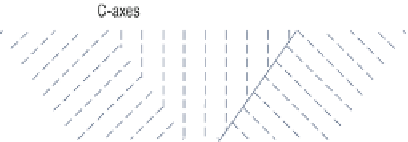Geoscience Reference
In-Depth Information
Lepp
ranta and Kosloff 2000). The size of the ice crystals depends largely on the rate of
growth so that the slower the growth the larger the crystals will be. Since thicker con-
gelation ice grows slower, the crystal size increases with depth, and typically large or extra
large crystals are found beneath a 10
ä
20 cm thick transition layer (Gow and Govoni
1983). The orientation of the c-axes depends on the structure of the primary ice (Gow
1986). If the c-axes of primary ice are vertical, this alignment is inherited to the conge-
lation ice below. However, if they are randomly oriented, the alignment turns horizontal
with depth. This process is called geometric selection, illustrated in Fig.
3.6
(Kolmogorov
1949; see also Pounder 1965; M
-
ller-Stoffels et al. 2009). Since a crystal grows faster
perpendicular to the c-axis, the crystals with vertical c-axes are closed out during the
growth process, and beneath the transition layer the c-axes are horizontal. In freshwater
ice the directions of c-axes are usually random in the horizontal plane. In saline waters,
preferred alignment in the direction of currents beneath the ice has been observed (Weeks
and Gow 1978).
When the vertical c-axis orientation prevails, congelation ice crystals are giant macro
grains (scale of 10 cm). Otherwise, when the c-axes turn horizontal, congelation ice layer
has a columnar crystal structure, diameter 0.5
ü
50 cm. In both cases the
crystal size increases with depth. The evolution is determined by external conditions, so
that in a
5 cm and height 5
-
-
fixed lake either type of congelation may occur.
Another possible secondary ice type is frazil ice, but this has not been reported from
lake ice
field investigations. Frazil ice forms in open water areas. In large lakes semi-
persistent open water spots are observed, and these would be potential sites for the
generation of frazil ice. It is therefore likely that frazil ice layers exist in large lakes but
available publications on lake ice crystal structure are too limited to con
rm this. The
crystals are small (1 mm or less), and they follow free with the water in turbulent
ow and
attach to the bottom of existing ice further downstream. If the spot remains open that may
lead to fast production of ice due to the large air
fl
lake temperature difference.
In turbulent, supercooled, shallow water, frazil ice can accumulate on the lake bottom
leading to anchor ice formation. This phenomenon is often observed in rivers but has not
been reported for freezing lakes. However, anchor ice is expected to occur where the
given conditions exist. As a follow-up, anchor ice could rise to the surface when its
buoyancy overcomes the binding forces at the bottom.
Superimposed ice forms on the top of the ice sheet, when liquid water or slush on ice
freezes. In the former case, the source of water is melting or precipitation, and as far as it
is known only a thin layer of ice is formed in this way on lake ice. Freezing of slush
-
Fig. 3.6
Geometric selection
in lake ice growth when the c-
axes are randomly oriented in
the primary ice layer Redrawn
from Pounder (1965)






Search WWH ::

Custom Search